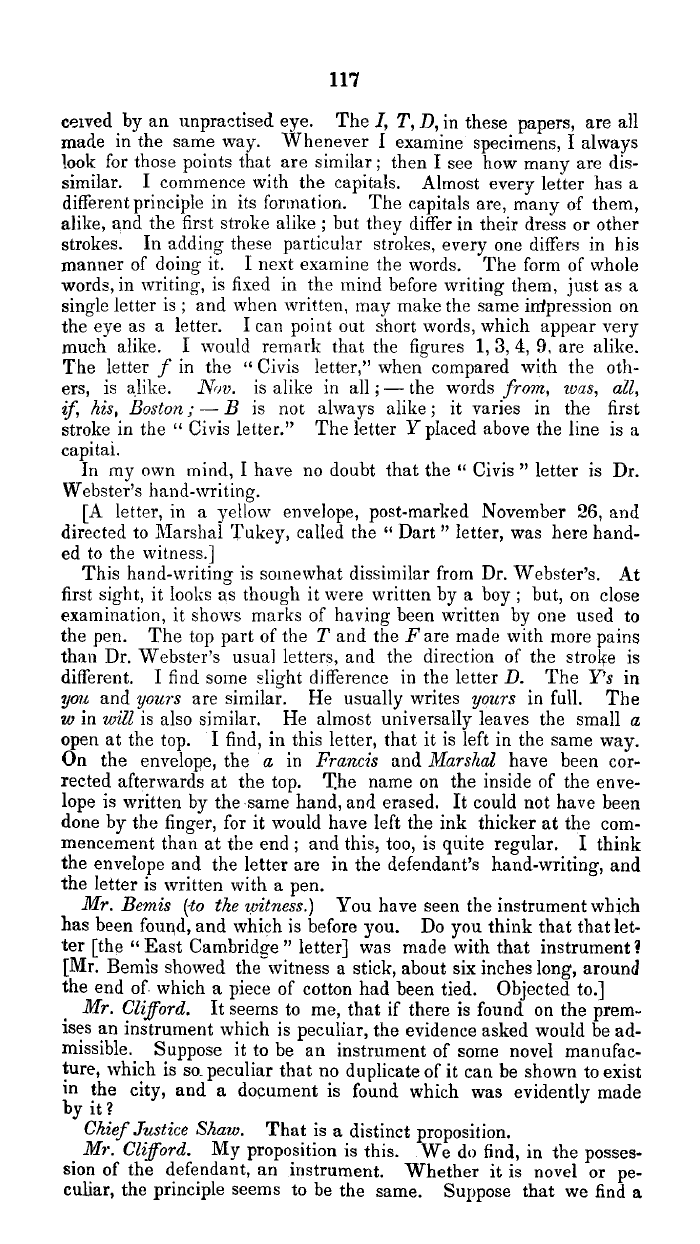|
117
ceived by an unpractised eye. The I, T, D, in these papers, are all
made in the same way. Whenever I examine specimens, I always
look for those points that are similar; then I see how many are dis-
similar. I commence with the capitals. Almost every letter has a
different principle in its formation. The capitals are, many of them,
alike, and the first stroke alike ; but thev differ in their dress or other
strokes. In adding these particular strokes, every one differs in his
manner of doing it. I next examine the words. The form of whole
words, in writing, is fixed in the mind before writing them, just as a
single letter is; and when written, may make the same impression on
the eye as a letter. I can point out short words, which appear very
much alike. I would remark that the figures 1, 3, 4, fi, are alike.
The letter f in the '° Civis letter," when compared with the oth-
ers, is alike. Nor. is alike in all; - the words from, was, all,
if, his, Boston ; - B is not always alike; it varies in the first
stroke in the " Civis letter." The letter Y placed above the line is a
capital.
In my own mind, I have no doubt that the " Civis " letter is Dr.
Webster's hand-writing.
[A letter, in a yellow envelope, post-marked November 26, and
directed to Marshal Tukey, called the °° Dart " letter, was here hand-
ed to the witness.]
This hand-writing is somewhat dissimilar from Dr. Webster's. At
first sight, it looks as though it were written by a boy ; but, on close
examination, it shows marks of having been written by one used to
the pen. The top part of the T and the Fare made with more pains
than Dr. Webster's usual letters, and the direction of the stroke is
different. I find some slight difference in the letter D. The Y's in
yon and yours are similar. He usually writes yours in full. The
w in will is also similar. He almost universally leaves the small a
open at the top. I find, in this letter, that it is left in the same way.
On the envelope, the a in Francis and Marshal have been cor.
rected afterwards at the top. The name on the inside of the enve-
lope is written by the-same hand, and erased. It could not have been
done by the finger, for it would have left the ink thicker at the com-
mencement than at the end ; and this, too, is quite regular. I think
the envelope and the letter are in the defendant's hand-writing, and
the letter is written with a pen.
Mr. Bemis (-to the witness.) You have seen the instrument which
has been found, and which is before you. Do you think that that let-
ter [the "East Cambridge" letter] was made with that instrument?
[Mr. Bemis showed the witness a stick, about six inches long, around
the end of. which a piece of cotton had been tied. Objected to.]
Mr. Clifford. It seems to me, that if there is found on the prem-
ises an instrument which is peculiar, the evidence asked would be ad-
missible. Suppose it to be an instrument of some novel manufac-
ture, which is so- peculiar that no duplicate of it can be shown to exist
in the city, and a document is found which was evidently made
by it?
Chief Justice Shaw. That is a distinct proposition.
Mr. Clifford. My proposition is this. We do find, in the posses-
sion of the defendant, an instrument. Whether it is novel or pe-
culiar, the principle seems to be the same. Suppose that we find a
|

